For anyone who would like to incorporate a sense of nature indoors, stocking in-house plants is one of the first solutions that comes to mind. However, not everyone has sufficient time and energy to take care of such plants, particularly the larger types. This is where opting for artificial alternatives may be the perfect way to achieve that ‘evergreen’ feel.
Read on to find out why faux plants are becoming popular today, and discover our list of the most popular types of artificial indoor plants for 2024.
Table of Contents
1. Overview of the global faux plants market
2. The most popular artificial plants of the year
3. Maintenance-free evergreens
Overview of the global faux plants market
Global market expansion
Despite being “fake” plants that maintain a constant size and appearance, the worldwide market’s expansion rate for artificial plants is notably encouraging. In fact, multiple reports highlight continuous upward trends from 2022 onwards until 2030.
For example, the global market size for artificial plants in 2023 is estimated to be between USD 730 million and USD 1019 million, according to two separate research reports.
With a healthy compound annual growth rate (CAGR) forecasted at 4.5% per year, the global artificial plants market is expected to reach approximately USD 1582 million by 2033, 10 years from the report’s base year.
The North American market, particularly the United States, which is often cited as having the highest number of amusement parks in the world, is the largest market for artificial plants. This is aside from their widespread use in public places such as airports, theme parks, and hotels.
The Asia Pacific, on the other hand, is widely regarded as the most promising upcoming market for artificial plants, albeit for a nearly entirely different range of uses: homes, commercial spaces, and the hospitality industry. All in all, considering the statistics above, it is evident that the outlook for the market is optimistic, reflecting a positive stance on the general growth rate of artificial plants and their versatile roles in enhancing both public and private spaces.
Why people love artificial plants
Most people express understanding and support when it comes to the love and efforts shown by plant enthusiasts or “plant parents,” evident in their passion frequently showcased on social media posts toward beloved plants or gardens.
But not many may grasp why people opt for artificial plants rather than fresh, real trees and plants. In reality, there are a number of compelling reasons behind such a choice:
1) Nature feels at lower physical and emotional costs: Artificial plants require almost no care, remaining unchanged through the seasons, presenting a truly evergreen option. This means less physical work in terms of watering, pruning, or soil management, and less emotional stress worrying about the health and growth of the plants.
Without all the need for high maintenance, they stand as an enduring, stress-free compliment to any space, providing a sense of nature with minimized physical and emotional burdens.
2) Safer choice: Opting for artificial plants also mitigates several safety concerns associated with real ones. They pose no risk to pets, making them a worry-free addition to anyone with animals. Additionally, they are free from allergens that might trigger sensitivities in some people, and perhaps the most significant advantage is the absence of pest infestations that could require the use of harmful chemicals.
Durability is another plus that bolsters the safety aspect of faux plants; unlike real plants that may suffer from under or overwatering, lack of light, or diseases, artificial plants remain consistent and safe from such issues.
3) Instant gratification and design highlight: Artificial plants provide immediate aesthetic pleasure without the lengthy days required for growth or waiting for seasonal blooms to enjoy their beauty. They serve as instant design elements that add elegance and light to any room, enhancing the ambiance with their meticulously crafted details.
This immediate satisfaction, combined with their ability to serve as a focal point in interior design, makes artificial plants a popular choice for adding character and sophistication to living spaces.
4) No restriction options: The versatility of artificial plants extends to their placement, as they are not constrained by environmental needs such as sunlight, air humidity, or temperature. This freedom allows for creative expression in decorating, enabling plants to be placed in areas where live plants would not thrive.
The absence of maintenance and care requirements further broadens the possibilities for incorporating greenery into various settings, from dark corners to high shelves, without worrying about accessibility for care.
In short, the decision to incorporate artificial plants into home or commercial spaces stems from their practicality, safety, and aesthetic appeal. They offer a hassle-free way to enjoy the beauty of nature, with the added advantages of safety, immediate satisfaction, and unrestricted placement options.
The most popular artificial plants of the year
Faux olive trees
From a long-established, renowned lifestyle magazine and website based in New York to a professional artificial plant specialist in Europe, olive trees have been well-recognized as among the most trendy plants since 2023, with expectations for their popularity to persist throughout 2024.
The corresponding Google Ads keyword analysis revealed similar trends, as the terms “artificial olive tree,” “fake olive tree,” and “faux olive tree” have consistently gathered more than 6000 average monthly searches collectively over the last 12 months, with competition indices reaching the maximum scale of 100 out of 100 for all three keywords.
Olive trees are indeed widely acknowledged as highly suitable for growing in pots, thanks to their drought tolerance and adaptability to container life. This makes them a practical replicate option for those who prefer potted plants, since the imitations of these faux olive trees are remarkably lifelike and natural, often also coming with relatively tall options of 2.5m and above, as shown in the picture above.
However, the growing space of olive trees is not restricted to traditional pots but is rather versatile. For example, as illustrated in the picture below, a fake olive tree can also be set within a large, sculptural planter instead of ordinary standard pots.
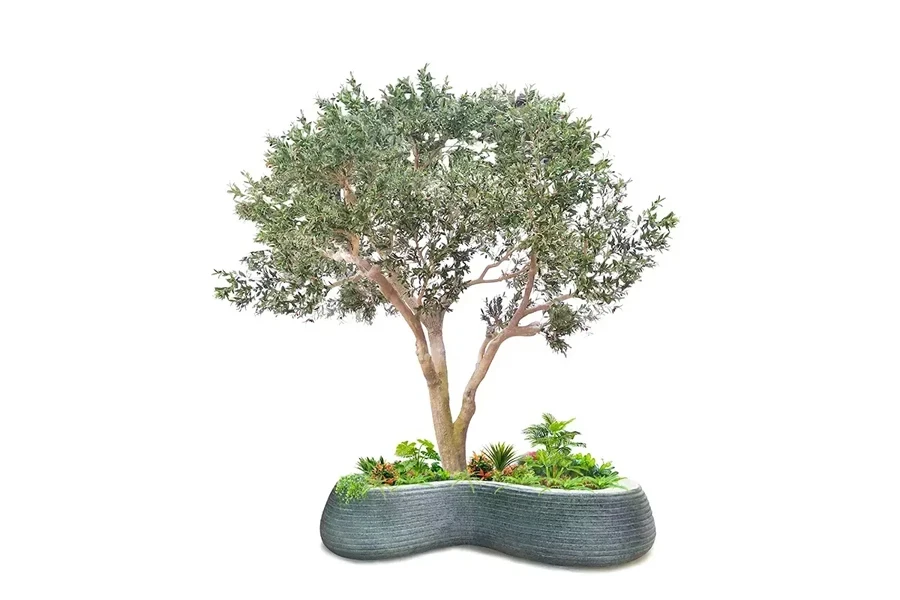
Basically, these faux trees can be “planted” in various scenarios, including garden settings, especially for those larger versions. And of course, aside from featuring tall and authentic-looking olive trees, some artificial olive trees feature burgeoning fruits and thick leaves, adding to their convincing and realistic appearance.
Artificial succulents
Similar to olive trees, succulent plants, or simply succulents—defined as “any plant with thick fleshy tissues adapted to water storage“—rank high among the trendiest plants in 2024, as noted by the same lifestyle site and artificial plant expert. On top of these two recognitions, succulent plants also receive additional acknowledgments as some of the best fake house plants requiring relatively low maintenance in 2024.
Indeed, the rather unique looks and often leafless, simple appearance of succulents stand out in terms of design, making them suitable for various modern home decor and company spaces. Their normally simple shapes, such as those featured in variants like Aloe Vera and Hens and Chicks, as shown in the image below, keep them looking lush and vibrant all the time, thereby maintaining an aesthetic appeal even when replicated as artificial succulent plants.
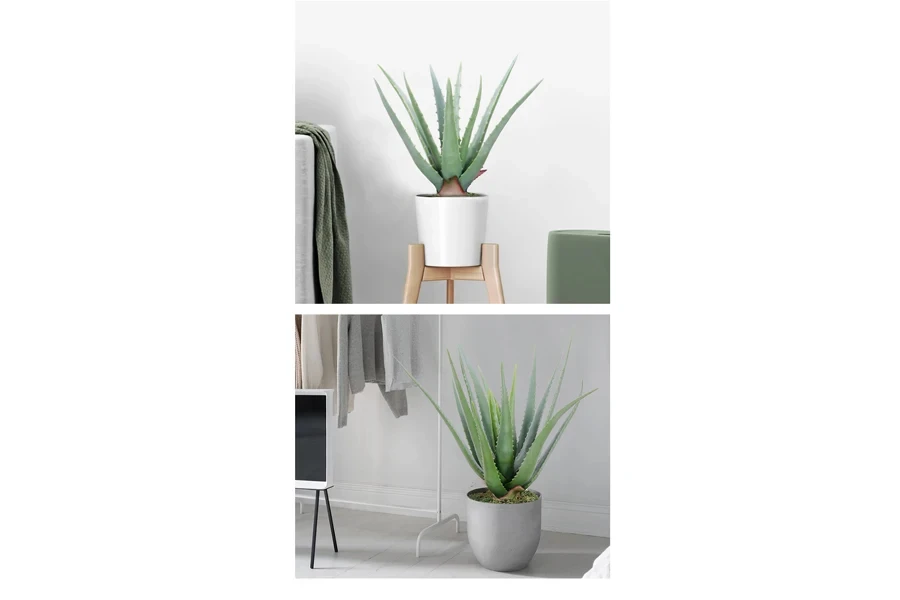
In the meantime, it’s worth noting that due to their typically water-retaining, enlarged stems or leaves, faux succulents often appear most authentic when made of silicone or rubber-based materials, as these materials not only bring out a realistic appearance but also a real-life texture.
Also, aside from Aloe Vera, faux cacti are equally popular as fake succulents. These cactuses, as depicted in the picture below, often come in different sizes, types, and colors, which can seamlessly and quickly add design elements to any space where they are placed.
Tropical artificial plants and trees
In the same vein as olive trees and succulents, another group of favorite house plants and artificial indoor trees in 2024 identified by both US and Europe-based industry professionals includes tropical plants and trees such as Monstera Deliciosa and heliconias. Among them, various kinds of artificial palm trees are specially highlighted on different websites as the most popular type of trees this year.
Such an observation is indeed aligned with the Google Trends report, which shows a 111% increase in search interests for the keyword “artificial tropical plant” over the past quarter. Correspondingly, Google Ads keyword analysis also reveals that the term “fake palm plant” has averaged 1600 monthly searches over the past 12 months, reaching around 1900 searches per month by the end of 2023.
In actuality, as shown in the picture below, the fact that artificial tropical plants are mostly green and their placements can therefore create an instant greenery scene and evoke a natural feel are apparently part of the reasons that accentuate their allure.
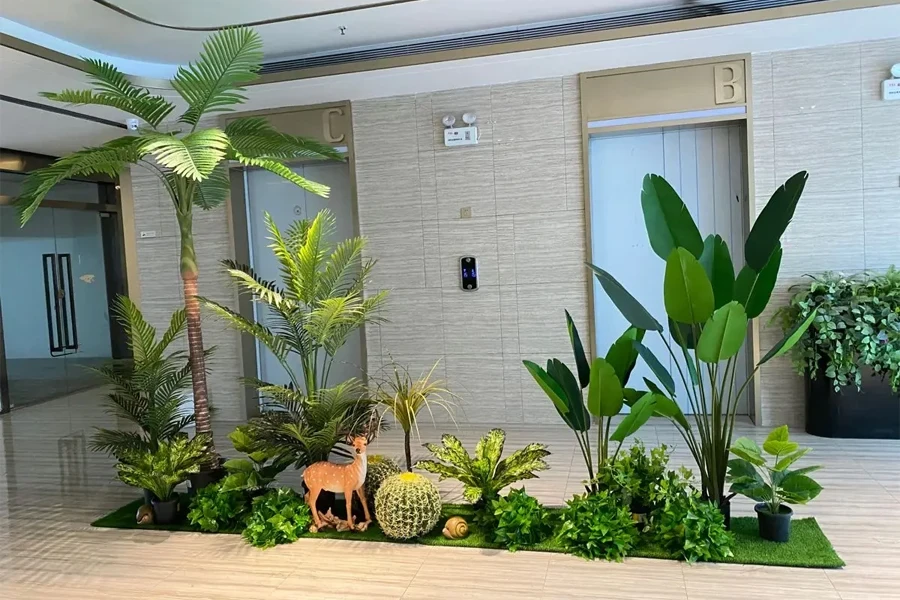
At the same time, the luxury, sense of relaxation, and exotic ambiance imparted by artificial palm trees, coupled with the fact that these tall plants have readily available replicas ranging from 6-10 feet or more, make them highly versatile for outdoor use as well. This is especially useful among individuals in the hospitality industry or those engaged in outdoor gardening ventures.
Overall, as featured in the picture below, in light of their aesthetic appeal with typically vivid, detailed leaves and vibrant flowers, their accuracy in colors, and successful level in mimicking the lushness and vibrancy of real tropical leaves are highly dependent on the quality of materials and textures.
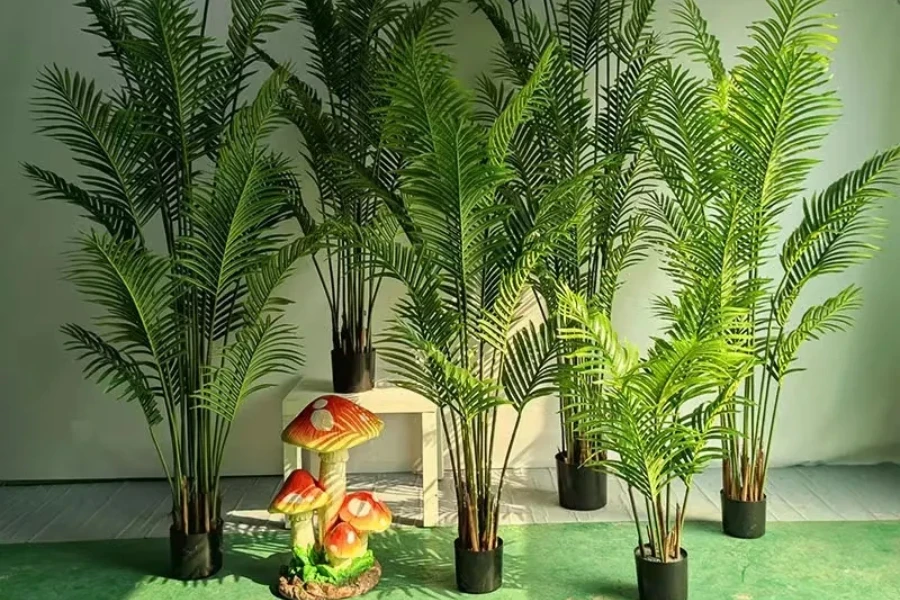
Artificial plant walls
As urban spaces are getting increasingly crowded, people are struggling to achieve a balance between space efficiency and aesthetically pleasing natural interior design and outdoor use. Plant walls, or plant curtains on a smaller scale, are hence clearly a solution to most space-deprived areas which yearn for a natural ambiance and oasis.
As evident by the Google Ads keyword analysis result and confirmed by European specialists in artificial plant walls, faux plant walls are gaining more attention now, with keywords such as “faux greenery walls” and “fake plant walls” having garnered an average of 1000 monthly searches in the past year.
Artificial plant walls are generally favored in view of their ability to provide similar eye-catching and noise-reducing benefits as their living counterparts but without all the hassles associated with them, such as watering, trimming, and the necessary care to maintain the plant’s health and appearance.
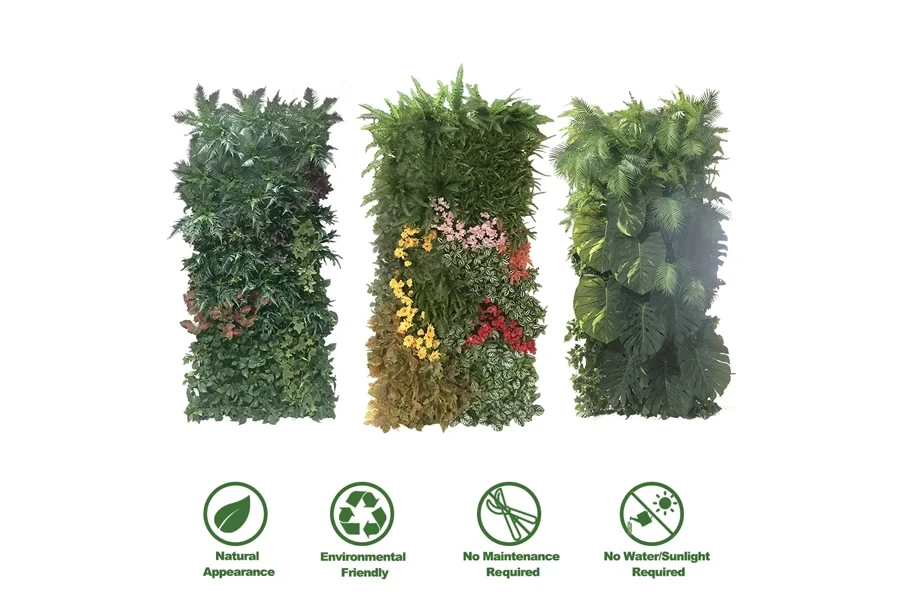
Simultaneously, as featured in the picture above, other apparent benefits of these faux greenery walls include their adaptability and highly customizable nature, which can be tailored according to different size requirements, thereby being highly adaptable to various environments, no matter the space constraint. There’s practically no size limit compared to traditional living plant walls, which typically come with certain minimal upkeep requirements.
Also, compared to the regular watering, fertilizing, pruning, and other standard maintenance needs of traditional living plant walls, fake plant walls generally serve as a much more cost-saving option while offering the same design appeal and fresh, natural feeling at the same time.
Miniature artificial plants
Another apparent trend that’s associated with limited urban space is the emergence of a wide variety of miniature fake plants. These are essentially miniature versions of various popular artificial plants, including mini tropical plants and mini succulents, as illustrated in the following picture.

This trend is clearly reflected in the Google Trends results over the past year, which show that the keyword “mini artificial plants” increased by 19% and reached around 1000 searches per month. Likewise, the same sentiment is echoed by several Europe-based plant specialist websites, which have highlighted the beauty and practicality of smaller plants.
Among all the plants suitable for miniature versions, mini succulents are the most popular due to their adaptability to grow in small spaces and containers. This makes them ideal for areas with limited space and mini gardens.
For this reason, artificial mini succulents, with their exquisite craftsmanship, can appear extremely authentic, often virtually indistinguishable from the real things. Consequently, they are generally recognized as among one of the most realistic faux plants, with many different varieties available for selection, as depicted in the picture below.
Maintenance-free evergreens
The surge in the faux plants market highlights an increasing demand for low-maintenance plants, with projections indicating expansion to USD 1.5 billion in the coming years, from 2023 to 2033. With North America leading and APAC rapidly growing, a rising number of consumers are turning to artificial plants for their ease, versatility, and immediate aesthetic appeal.
Faux olive trees, fake succulents, tropical varieties like artificial palm trees, artificial plant walls as well as mini faux plants are among the trendiest choices in 2024, all of which are highly celebrated for their minimal upkeep and design flexibility.
These trends reflect a shift towards a stress-free yet stylish home decor world and commercial space decorations. Essentially, the popularity of these faux plants lies in their ability to create an instant connection with nature, and a blend of safety, convenience, and style, suitable for any setting.
For more on the latest wholesale news, trends, and other insights, Alibaba Reads serves as a valuable resource for enthusiasts and professionals alike.




